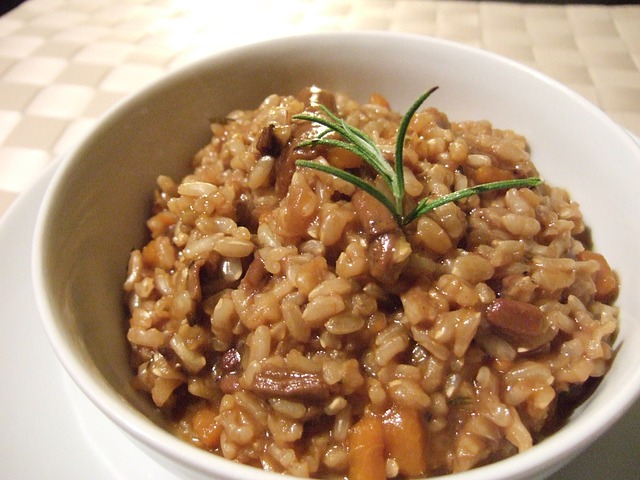 Brown rice is whole grain rice; unhulled and unmilled and can be any type of rice including glutinous, long and short grain. It has a mild, nutty flavor and is chewier and more nutritious than white rice, though the calorie and carbohydrate contents are similar. White rice had has the bran and germ removed; these contain fats that can go rancid more quickly in brown rice giving it a shelf life of about 6 months. Water management issues in farming have resulted in higher levels of arsenic and cadmium and in some reports also lead and mercury in brown rice than in white rice.
Brown rice is whole grain rice; unhulled and unmilled and can be any type of rice including glutinous, long and short grain. It has a mild, nutty flavor and is chewier and more nutritious than white rice, though the calorie and carbohydrate contents are similar. White rice had has the bran and germ removed; these contain fats that can go rancid more quickly in brown rice giving it a shelf life of about 6 months. Water management issues in farming have resulted in higher levels of arsenic and cadmium and in some reports also lead and mercury in brown rice than in white rice.
Nutrition: Brown rice is rich in Vitamin B3 (niacin), B5 (pantothenic acid), B6 (pyridoxal 5 phosphate), B1 (thiamine), B2 (riboflavin) with traces of folate; rich in minerals phosphorus, potassium, magnesium, calcium with traces of sodium, manganese, zinc and iron; contains protein, dietary fibre and fat. Several nutrients are lost in making white rice; some of the B vitamins and iron are added back, though magnesium is not and nor is the bran oil, which may help lower LDL cholesterol. It also contains bioactive components, such as γ-oryzanol, gamma aminobutyric acid (GABA), ferulic acid, phenolic acids, flavonoids, anthocyanins, proanthocyanidins, tochopherols, tocotrienols, phytic acid, acylated steryl β-glucoside.
Benefits: Many physiological effects, including anti-oxidant, anti-hyperglycemia, anti-hyperlipidemia, anti-hypertension, anti-thrombosis, hypo-cholesterolemia, low insulin index, neuro-protective effects and reduction in risk of some chronic diseases such as cancer, diabetes, cardiovascular disease, anxiety disorders and Alzheimer’s disease.
Anti-Cancer: Due to high anti-oxidant capacity, high phenolic and anthocyanin content, prevention of colorectal, gastric, pancreatic, oesophageal and liver cancer, also intestinal polyps. Consumption of brown rice at least once a week reduced colorectal cancer risk by 40%.
Anti-Inflammatory: Due to anthocyanins; suppresses production of inflammatory cytokines and chemokines.
Anti-Oxidant: Due to phenolic acids, flavonoids, anthocyanins, proanthocyanidins, tochopherols, tocotrienols, y-oryzanol and phytic acid; the scavenging of free radicals by anthocyanins offers protection against degenerative disease. Except for anthocyanins and y-oryzanol, anti-oxidant content is higher in cereals than grains.
Cardiovascular: May be useful to decrease inflammatory marker levels and several cardiovascular risk factors among non-menopausal overweight or obese female; also in lowering atherosclerosis cardiovascular disease risk. Lowers blood pressure.
Cholesterol: Lowering, more studies needed.
Colitis: Suppressive effect on the induction of colitis by dextran sulfate sodium.
Diabetes: Due to bioactive compounds like γ-aminobutyric acid (GABA), γ-oryzanol, dietary fibre, phenolicsnti-hypertensive effect, hypocholesterolemia, and neuroprotective effects. Long term studies needed. Y-oryzanol direc, vitamins, acylated steryl β-glucoside, and minerals; anti-hyperglycemia, low insulin index, anti-oxidative effect, anti-thrombosis, atly acts on pancreatic islets and enhances glucose-stimulated insulin.
Hepato–protective: Due to anthocyanins influence on liver processes; high level of gamma-aminobutyric acid (GABA) may have nutraceutical role in the recovery from and prevention of chronic alcohol-related diseases.
Immune: Modulating also due to anti-inflammatory properties.
Obesity: Brown rice and γ-oryzanol may have potential for treatment of obesity and type 2 diabetes. May be useful in controlling body weight as well as blood glucose and lipid levels in Vietnamese women with impaired glucose tolerance. Consuming brown rice decreased waist circumference in type 2 diabetic patients. Further study needed.
Adding Brown Rice to your Diet:
Brown rice can be soaked in water at 30 °C for specified hours for germination to get Germinated brown rice. Soaking for 3 hours and sprouting for 21 hours has been found optimum for getting the highest gamma-aminobutyric acid (GABA) content, the main reason behind its popularity.
- Substitute white rice for brown rice where possible, even if not soaking and germinating.
- For a simple rice meal add vegetables such as broccoli, carrots (chopped or grated), spinach, onions, garlic, etc. towards the end of cooking the rice; also seeds such as pumpkin, sesame, sunflower; chopped feta cheese; paprika or cayenne, black pepper and Himalayan salt; drizzle with olive oil.
- Make rice salads and puddings.
We are happy to advise you on your health matters.
 Lin Bridgeford DO KFRP MICAK MICRA FSCCO MSc
Lin Bridgeford DO KFRP MICAK MICRA FSCCO MSc
Registered Osteopath & Kinesiologist & Yoga Teacher
Aether Bios Clinic
Saltdean
01273 309557
07710 227038
